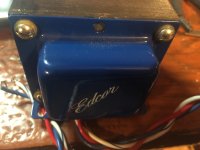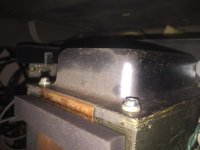This is something that Scott, Fisher, Heathkit, etc all missed?
I'm still scratching my head on this.
I think some of them used a flange to mount the transformer rather than thru-lamination bolts.
See the attached build guide for a heathkit W4 for example. Page 6, note 9.
Last edited:
Upload still missing. Apparently 3mb too big..
http://www.tubebooks.org/file_downloads/W4-AM_Manual.pdf
http://www.tubebooks.org/file_downloads/W4-AM_Manual.pdf
Thanks for the transformer info/hints.
I'll have to check/modify some of my builds, I guess.
When I have some time, I'll dive into my parts shelf and check out some of the salvaged iron I have; I'm curious to see if any of the PTs have the tubes inside the laminations.
It's funny- the amp that I had the most problems with mechanical hum and PT heating was using stand-up transformers with the usual flange attachment.
I'll have to check/modify some of my builds, I guess.
When I have some time, I'll dive into my parts shelf and check out some of the salvaged iron I have; I'm curious to see if any of the PTs have the tubes inside the laminations.
It's funny- the amp that I had the most problems with mechanical hum and PT heating was using stand-up transformers with the usual flange attachment.
Different kit, but still deja-vu for me...
Building something better with a Chinese SE EL34B Amp DIY Kit
Thanks for posting. I knew you'd built an amp from a kit, but couldn't find your thread after searching for a while. Geez, 2011.
jeff
I don't understand the binding post array. Four red and two black?
If it's like mine, it's Common, 4 ohm,8ohm on each side.
Geez, 2011.
Yup - lately I'm pulling out stuff I've had for '3 or 4 years', and find it's actually 8-12 years!
Sorry, off topic.
Here is a couple of examples: Edcor and Hafler.
You can see, Hafler uses a shorted turn around the transformer, to short the field that goes around, to decrease interference with wires in the amp.
You can see, Hafler uses a shorted turn around the transformer, to short the field that goes around, to decrease interference with wires in the amp.
Attachments
Last edited:
Found this among many other insights: "Should the transformer be of 'conventional' construction (not a toroidal), then the transformer body - the steel core - must be connected to chassis directly. Do not use any loop breaker circuit to isolate the transformer core, as it is unnecessary and dangerous to do so."
Bolts have to be insulated. No need to insulate nuts at the opposite side. Additional nuts create an air gap between transformer and the chassis, for better cooling. You can insulate 3 of 4 bolts; one would ground the lid.
I've seen the copper loop OUTSIDE of the tranny many times in both SS and VT. It does a lot to stop stay magnetic fields of 60hz hum looking for an antenna.
I had forgotten about all of the fiber washers I had as a kid from disassembling stuff. Always thought they were for hum and buzz. All of the IE trannies I've worked with before were either ugly flange mounted that I used as is or PC mounted with or without the wrap around sheet metal clamp. I never stopped to ponder it.
With such cheap chinese kits, you can't take anything for granted. They truly have to be treated as a (hopefully) complete BOM and you supply all of the skill AND knowledge.
I had forgotten about all of the fiber washers I had as a kid from disassembling stuff. Always thought they were for hum and buzz. All of the IE trannies I've worked with before were either ugly flange mounted that I used as is or PC mounted with or without the wrap around sheet metal clamp. I never stopped to ponder it.
With such cheap chinese kits, you can't take anything for granted. They truly have to be treated as a (hopefully) complete BOM and you supply all of the skill AND knowledge.
One thing I'm going to keep in mind after this discussion:
It doesn't matter how the transformer mounts to the chassis - flange mounting is no 'protection' from this 'shorted turn' issue. Any transformer that has bell ends bolted together is subject to this problem - it's the bells and the bolts that comprise the 'shorted turn', as I understand it. Is the assumption that the laminations are non-conductive, so that insulating the bolts will keep the end bells 'disconnected' from each other?
I also don't see how the 'shield' works into the 'shorted turn' idea.
It doesn't matter how the transformer mounts to the chassis - flange mounting is no 'protection' from this 'shorted turn' issue. Any transformer that has bell ends bolted together is subject to this problem - it's the bells and the bolts that comprise the 'shorted turn', as I understand it. Is the assumption that the laminations are non-conductive, so that insulating the bolts will keep the end bells 'disconnected' from each other?
I also don't see how the 'shield' works into the 'shorted turn' idea.
Laminations can have some contacts, but not form a significant shorted turn.One thing I'm going to keep in mind after this discussion:
It doesn't matter how the transformer mounts to the chassis - flange mounting is no 'protection' from this 'shorted turn' issue. Any transformer that has bell ends bolted together is subject to this problem - it's the bells and the bolts that comprise the 'shorted turn', as I understand it. Is the assumption that the laminations are non-conductive, so that insulating the bolts will keep the end bells 'disconnected' from each other?
A shield adds loss, but insignificant, since it is outside of the magnetic path. However, the shield between layers must not be shorted!I also don't see how the 'shield' works into the 'shorted turn' idea.
I still don't understand....not very smart today, I guess.
The shield is 'insignificant' because it is 'outside' the magnetic field (it isn't, really, is it- doesn't the field extend past the laminations? Bring your electric guitar close to the transformer and you will know...) but a bolt which is a couple of mm inside the edge of the laminations is a major problem?
Or is it insignificant because the shield is usually copper (not 'magnetic') and the bells and bolts are steel?
The shield is 'insignificant' because it is 'outside' the magnetic field (it isn't, really, is it- doesn't the field extend past the laminations? Bring your electric guitar close to the transformer and you will know...) but a bolt which is a couple of mm inside the edge of the laminations is a major problem?
Or is it insignificant because the shield is usually copper (not 'magnetic') and the bells and bolts are steel?
Here is mine. No need for measurements, after the whole day of playing. 
Wavebourn - Testing temperature | Facebook
Wavebourn - Testing temperature | Facebook
- Status
- This old topic is closed. If you want to reopen this topic, contact a moderator using the "Report Post" button.
- Home
- Amplifiers
- Tubes / Valves
- Another Newbie Who Bought a Cheap Chinese Tube Amp Kit

